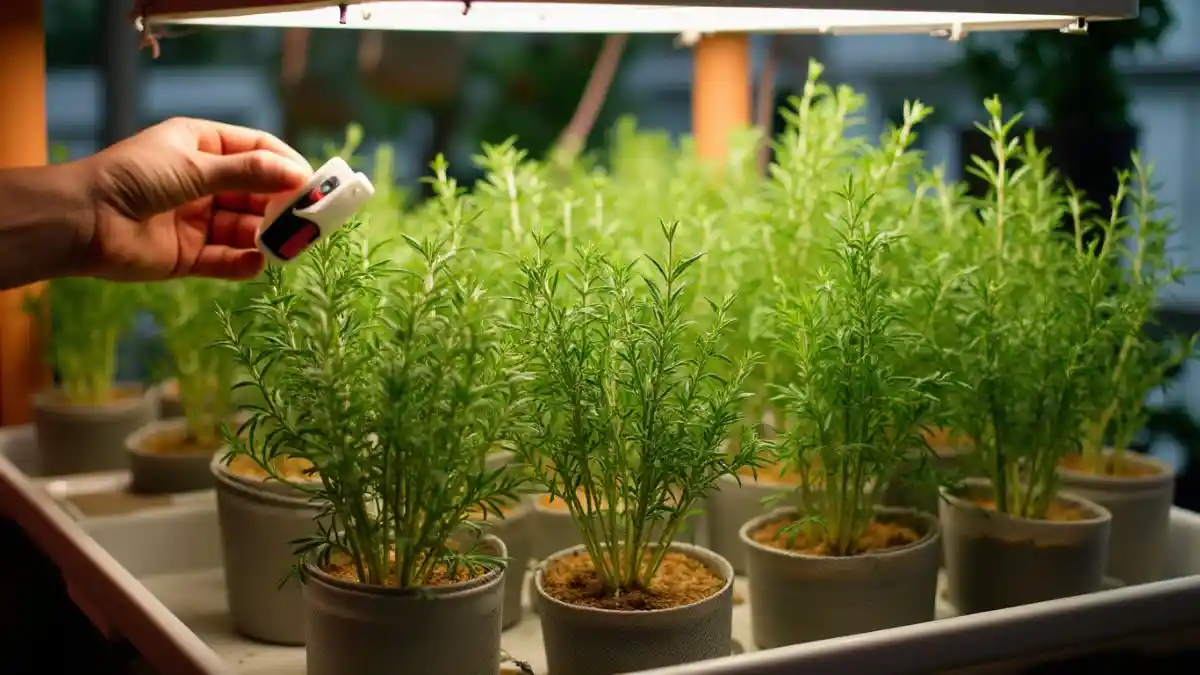Growing hydroponic rosemary offers an exciting way to cultivate this fragrant herb without the mess and limitations of traditional soil gardening. Whether you’re a seasoned gardener or just starting out, hydroponics provides a cleaner, more efficient approach to growing plants indoors. If you’re ready to elevate your gardening game, this guide offers 7 expert tips that will help you grow rosemary faster and more effectively.
Table of Contents
Why Grow Hydroponic Rosemary? The Benefits of Soilless Cultivation
Before we dive into the tips, it’s important to understand why hydroponic rosemary is such a great choice for indoor and year-round gardening. If you’ve ever struggled with growing rosemary in soil, you’ll love the benefits that hydroponics bring.
1. Faster Growth
Hydroponic systems allow rosemary to absorb nutrients more efficiently, promoting faster root development and quicker overall growth. With all the nutrients directly available in the water, rosemary doesn’t waste energy searching for food. It grows at a faster pace compared to soil-based plants.
2. Year-Round Harvest
One of the major advantages of hydroponics is that it allows you to grow your hydroponic rosemary indoors, regardless of the season. Say goodbye to weather restrictions. You can grow fresh, flavorful rosemary all year long with the right setup and care.
3. Fewer Pests and Diseases
Hydroponic systems eliminate the presence of pests like aphids, beetles, and fungi that thrive in the soil. Without soil, your hydroponic rosemary plants are at less risk of diseases and pest infestations. This translates to healthier plants, less maintenance, and more reliable growth.
4. Space Efficiency
Whether you’re limited to a small apartment or have minimal outdoor space, hydroponic systems provide a space-saving solution. You can grow hydroponic rosemary in compact systems, like a countertop setup or a vertical tower, that don’t require large amounts of space.
How to Grow Hydroponic Rosemary Successfully
Now that you understand the perks of growing hydroponic rosemary, it’s time to get down to the specifics. Below are the 7 expert tips to help you grow your rosemary faster and healthier in a hydroponic system.
1. Choose the Best Hydroponic System for Rosemary
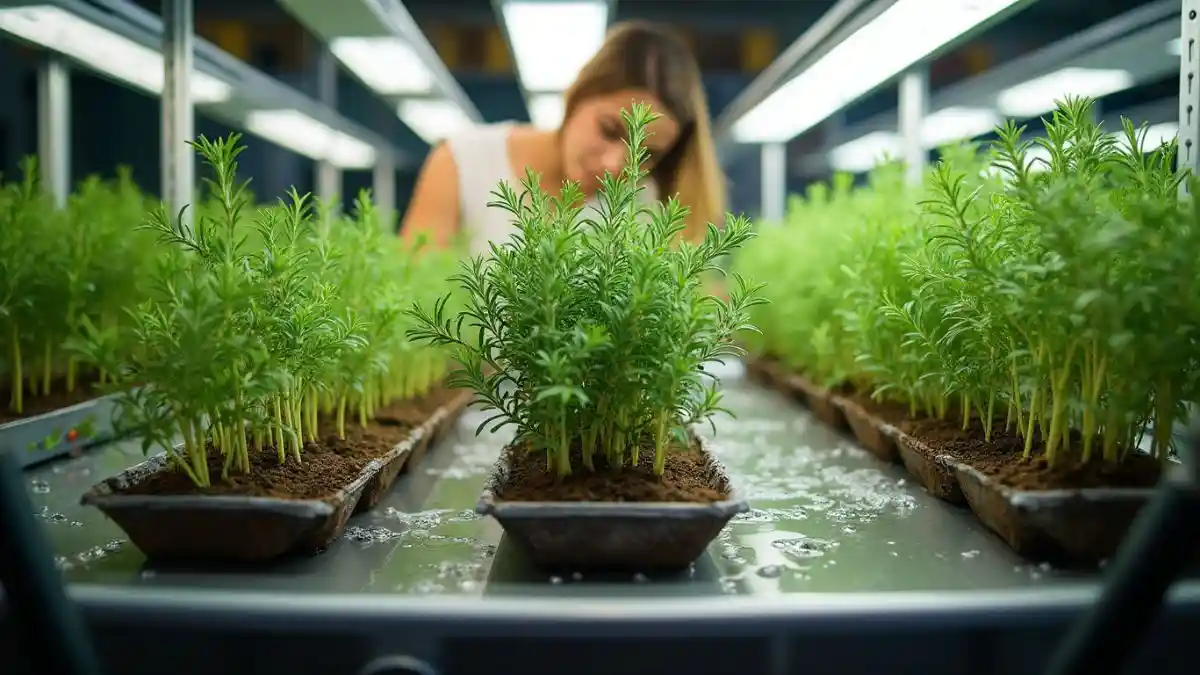
Not all hydroponic systems are equal when it comes to growing hydroponic rosemary. Some are more efficient than others at providing the right nutrients and oxygen. Here are a few systems you should consider:
Deep Water Culture (DWC)
DWC systems are perfect for rosemary as they provide consistent access to nutrients and oxygen. Rosemary plants love to have their roots submerged in water, and with a DWC system, you can ensure they get the oxygenated water they need. This system is great for fast-growing plants like rosemary.
Kratky Method
If you’re just getting started with hydroponics and don’t want to deal with a lot of equipment, the Kratky method is an excellent, low-maintenance option. In this system, plants are suspended above nutrient-rich water without requiring pumps. It’s simple and effective for growing rosemary indoors.
Nutrient Film Technique (NFT)
The NFT system allows a thin film of nutrient solution to flow over the plant roots. This system is best suited for plants that need a constant water supply, and it’s ideal for rosemary, which requires a lot of oxygenation. However, it needs more monitoring to ensure the nutrient film is flowing properly.
2. Use a High-Quality Hydroponic Nutrient Solution
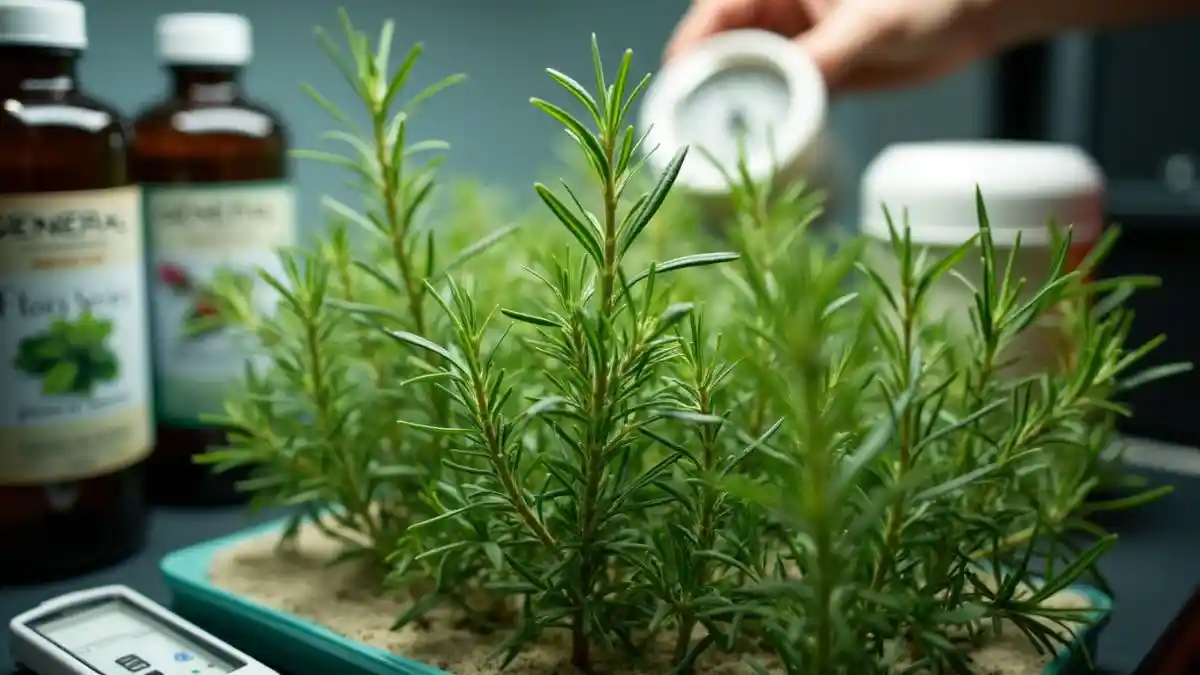
For hydroponic rosemary to thrive, it’s essential to provide it with the right nutrients. In a hydroponic system, plants absorb nutrients directly from the water. Here are the key nutrients rosemary needs to grow effectively:
- Nitrogen (N): Promotes leafy growth, ensuring that your rosemary grows lush and vibrant.
- Phosphorus (P): Helps strengthen the roots and stems, which is essential for healthy growth.
- Potassium (K): Enhances flavor and helps the plant become more resistant to diseases and stress.
- Calcium and Magnesium: Prevent yellowing leaves and encourage healthy cell function in the plant.
Using a balanced hydroponic nutrient solution will ensure that your hydroponic rosemary grows faster and is healthier. Some popular nutrient brands for hydroponic rosemary include General Hydroponics Flora Series and Botanicare Pure Blend Pro.
3. Maintain the Ideal pH and EC Levels
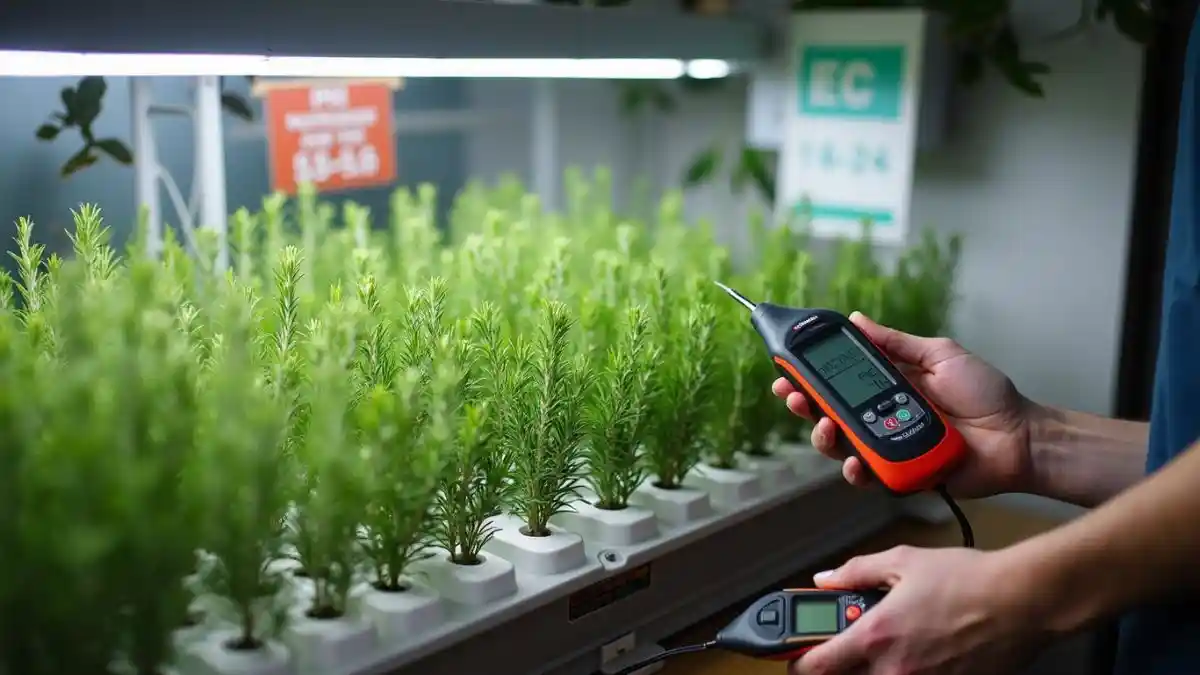
In hydroponics, maintaining the correct pH and EC (Electrical Conductivity) is crucial for the health and growth of your rosemary. Here’s what you need to know:
- pH Range: The ideal pH for hydroponic rosemary is between 5.5 and 6.5. If the pH is too high or too low, the plant will have difficulty absorbing the nutrients it needs, resulting in poor growth.
- EC Range: For optimal rosemary growth, maintain an EC level between 1.6 and 2.4. A higher EC means a stronger concentration of nutrients, while a lower EC means the solution is too weak.
Make sure you check the pH and EC levels regularly using digital meters and adjust as needed.
4. Provide the Right Light Conditions for Hydroponic Rosemary
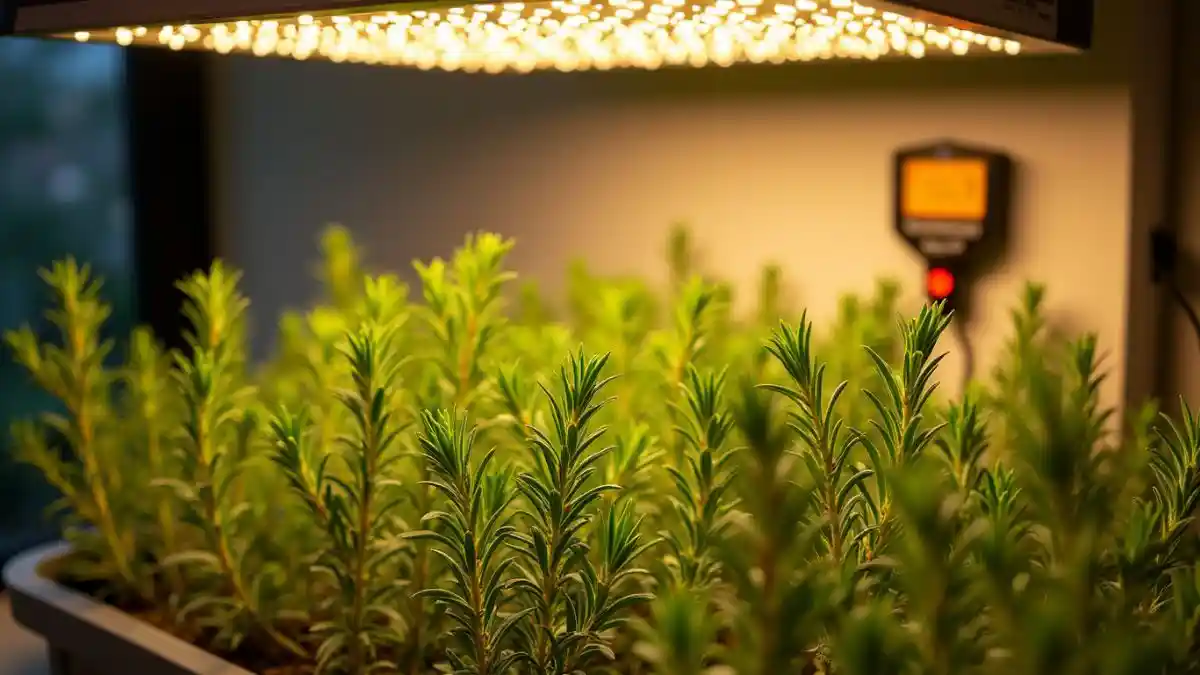
Hydroponic rosemary plants need at least 12-14 hours of light daily to thrive. Since rosemary is native to Mediterranean regions with plenty of sunlight, it needs intense lighting for healthy growth.
Best Grow Lights for Rosemary
The best lights for growing rosemary hydroponically indoors are full-spectrum LED lights, which mimic natural sunlight. A good LED grow light, like the Spider Farmer SF-1000, can provide your plants with the right spectrum of light they need to grow strong and healthy.
If you’re growing your rosemary in a low-light space, you can increase the light intensity and duration to give your plant the best chances of thriving.
5. Ensure Proper Water Circulation & Oxygenation
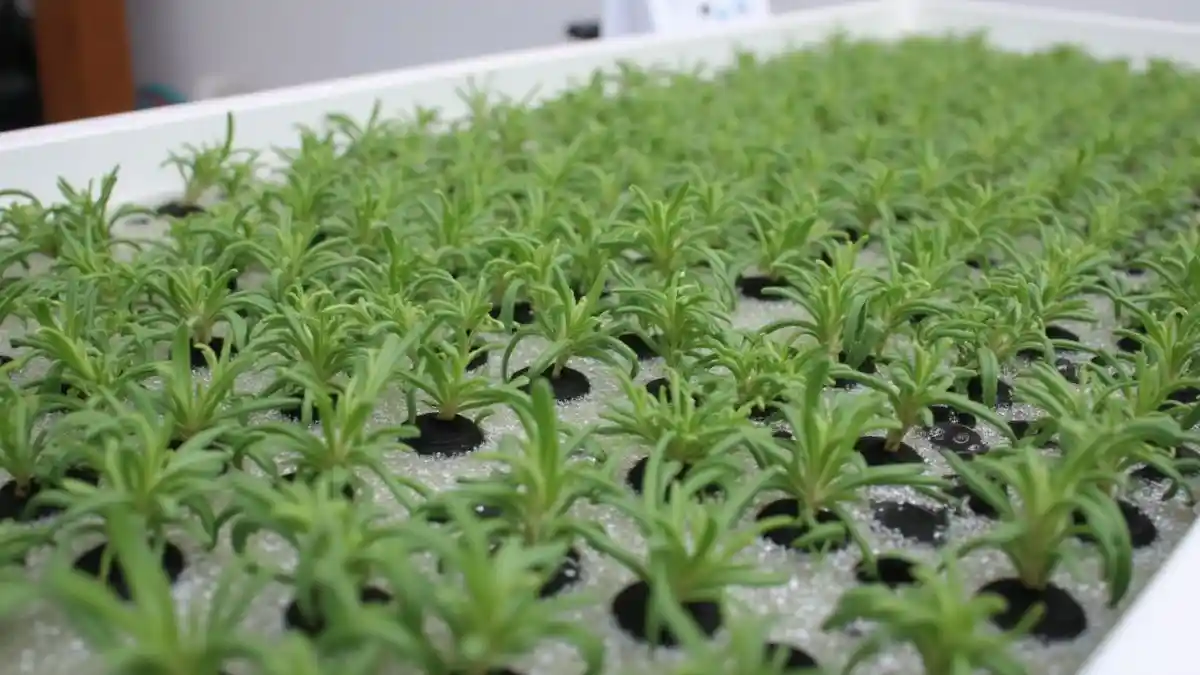
Water is the key to growing healthy hydroponic rosemary. Rosemary requires oxygenated water to keep its roots healthy and avoid rot. Without oxygen, your rosemary’s roots will suffocate, causing the plant to wilt and die.
In a DWC system, ensure your water is oxygenated by using an air pump and air stones to keep the water oxygen-rich. Regularly monitor the water temperature, as it should stay within the range of 65°F to 75°F (18°C to 24°C). Water that’s too hot or too cold can shock the plant and stunt its growth.
6. Prune and Harvest Regularly to Promote Growth

Pruning is essential for keeping your hydroponic rosemary plants bushy and productive. Regular pruning helps the plant stay compact and encourages new growth. Here’s how you can do it:
- Prune every 4-6 weeks to prevent legginess and to stimulate new branch growth.
- Always use clean, sharp scissors to avoid introducing bacteria or fungi.
- Harvest the top 2-3 inches of the rosemary stalk to keep the plant healthy and encourage further branching.
Pruning not only enhances the aesthetics of your rosemary but also makes it easier to harvest the herbs you need for cooking.
7. Prevent Common Hydroponic Rosemary Problems
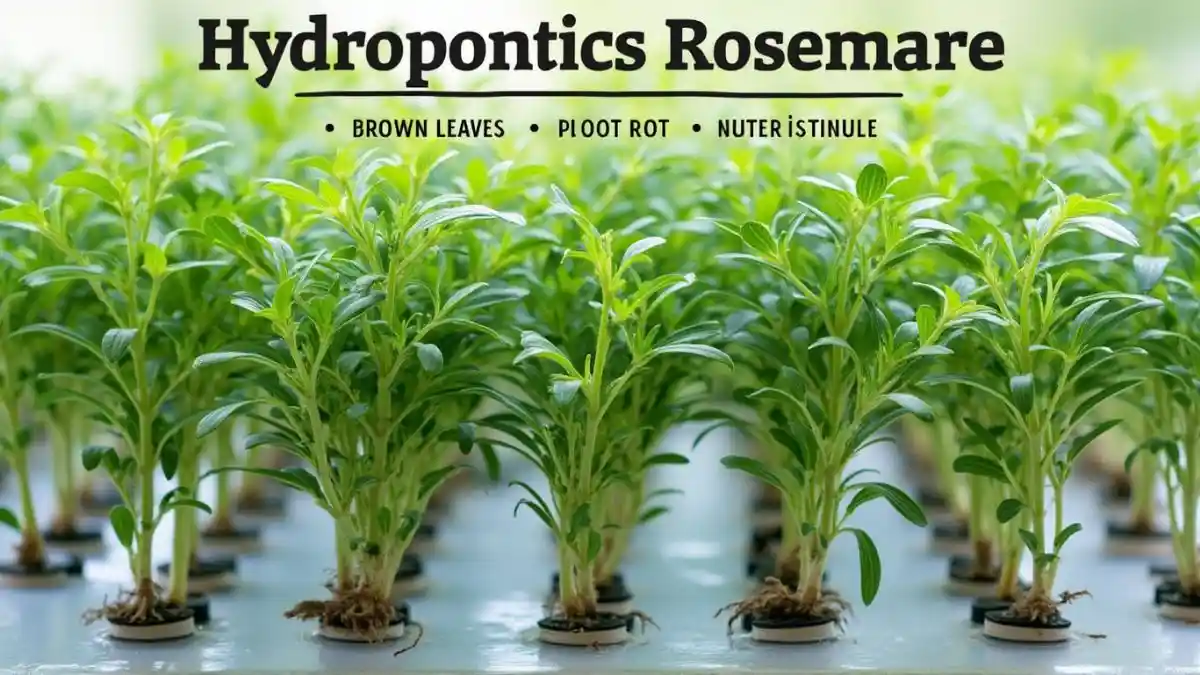
Despite all the advantages of growing hydroponic rosemary, there are still some challenges you might encounter. Here’s how to deal with the most common problems:
Why Is My Rosemary Turning Brown?
Brown leaves are usually a sign of nutrient deficiencies, root rot, or water quality issues. To fix this, check your nutrient levels, make sure your roots are getting enough oxygen, and replace the water regularly.
Why Is My Rosemary Turning Yellow?
Yellowing leaves may indicate a nitrogen deficiency or pH imbalance. Check the pH levels of your nutrient solution and adjust accordingly.
How to Use Fresh Hydroponic Rosemary in Cooking
Once your hydroponic rosemary is ready to harvest, you can use it in a variety of culinary applications. Fresh rosemary adds an aromatic flavor to dishes such as roasted meats, potatoes, and pasta. It’s perfect for making rosemary-infused oils, or for use in sauces, marinades, and even desserts.
Here’s a simple recipe you can try:
Rosemary-Infused Olive Oil
| Ingredient | Quantity |
| Fresh rosemary | 5–6 sprigs |
| Olive oil | 1 cup |
| Garlic (optional) | 2 cloves |
Instructions:
- Heat the olive oil on low heat.
- Add rosemary and garlic (optional).
- Let it simmer for 10-15 minutes, allowing the rosemary to infuse.
- Strain the oil and transfer it to a glass bottle for storage.
FAQ – Common Questions About Hydroponic Rosemary
Q1: How long does rosemary take to sprout in hydroponics?
Typically, rosemary takes 2-3 weeks to sprout in a hydroponic system. It takes some patience, but once sprouted, it grows relatively fast.
Q2: Can I grow rosemary hydroponically indoors?
Yes! Hydroponic rosemary thrives indoors when provided with sufficient light, nutrients, and proper care.
Q3: What’s the best hydroponic system for rosemary?
The DWC system is highly recommended for hydroponic rosemary, as it allows for optimal oxygenation and nutrient absorption.
Q4: Why is my rosemary plant turning brown?
Brown leaves on your hydroponic rosemary are often a sign of nutrient deficiencies, root rot, or water quality issues. Check your nutrient solution for imbalances and ensure your water is properly oxygenated. If your rosemary’s roots are submerged in stagnant water, root rot could be the culprit. Regular water changes and proper aeration can help fix the issue.
Q5: Why is my rosemary plant turning yellow?
Yellowing leaves typically indicate a nitrogen deficiency or pH imbalance in your nutrient solution. Adjust the pH to the ideal range (5.5 to 6.5) and check the nutrient levels. Ensure your rosemary is receiving sufficient nitrogen to keep the leaves green and healthy.
Conclusion
Growing hydroponic rosemary is not only rewarding but also convenient, offering a fresh, aromatic herb year-round. By following the expert tips in this guide, you’ll be well on your way to cultivating thriving rosemary plants quickly and easily. Whether you’re a seasoned gardener or a beginner, hydroponic rosemary is a perfect choice for indoor gardening enthusiasts.
Ready to start growing your hydroponic rosemary today? Set up your hydroponic system and enjoy fresh, flavorful rosemary in no time!


